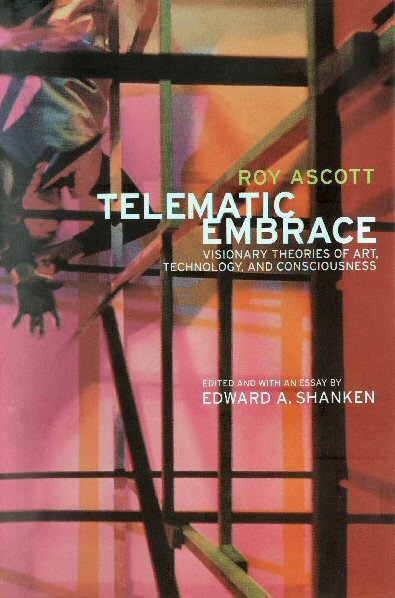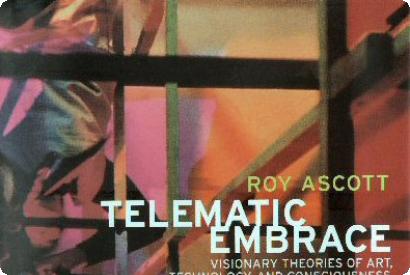Please wait a few moments while we process your request

Roy Ascott, Telematic Embrace
Ascott, Roy. — Telematic embrace : visionary theories of art, technology, and consciousness. — Edited by Edward A Shanken. — Berkeley : University of California Press, 2003. — 464 p. — ISBN 0520218035.
Since the 1960s, Roy Ascott has been producing media installations and publishing essays highlighting the theoretical implications of his work. In 1994, he founded the Centre for Advanced Inquiry in the Interactive Arts (Caiia) at the University of Wales (Newport, Wales, U.K.).
By way of introduction to this collection, a 95-page essay by Edward A. Shanken outlines Ascott's trajectory, beginning with an analysis of works from the 1960s onward employing retrospective effects and concluding with an overview of network art works created in the 1980s and 1990s. Shanken situates Ascott's work within the history of media arts since 1960, while linking artistic statements to the theoretical discourses serving as their foundation (cybernetics, communication theory, cognitive science, postmodernism). A significant portion of Shanken's contribution is devoted to recalling the first experiments by artists who wanted to appropriate telecommunications tools (satellites, cable television, etc.). He also emphasizes the relationship between Ascott's artistic project and the dematerialization strategies employed in conceptual art.
The collection includes essays first published by Ascott between 1964 and 2000 in specialized technological art and science journals as well as in conference proceedings.
In a group of essays written in the 1960s and 1970s, Ascott attempted to define a paradigm for art in the information age. He applied postulates from cybernetics and behaviourism to works using technological devices and encouraging the spectator's participation. According to Ascott, such works have the ability to alter the behaviour of those experiencing them, and so act retroactively on a societal level. In the essays written during this period, he also presented his vision for the teaching of the artistic disciplines by arguing that the learning process ought to proceed through the accumulation of knowledge.
Starting in the 1980s and 1990s, Ascott's thinking was increasingly influenced by the growing accessibility of telecommunications technologies (videoconferencing, computer networks), which provided solid and sophisticated technological propositions to support the postulates he had been advancing theoretically since 1963. In parallel with his production of major works, Ascott outlined a definition of art informed by the concepts of telematics, networking, interactivity and interface - terms that were just starting to come into use in the arts.
In speculating on the space created by networks, where geographical boundaries and the physicality of the body fade, Ascott was able to renew the relevance of concepts drawn from the metaphysics of Theilard de Chardin as well as from certain Asian philosophies. In addition to theoretical ponderings, the essays of this period (most of which were published before the emergence of the Internet) include descriptions of network projects produced for major artistic events (Les immatériaux exhibition at the Centre Georges Pompidou in 1985, the Venice Biennale in 1986, Ars Electronica in 1989) and involving participants located in several places around the world discussing ideas related to the emergent media space. This part of the collection also includes texts discussing the status of photography in the digital age, and architecture, the museum and nature in a media-saturated environment; also included is a glossary of one hundred terms (of which a good number were coined by Ascott) aimed at providing guideposts for the "post-biological era".
Since the 1960s, Roy Ascott has been producing media installations and publishing essays highlighting the theoretical implications of his work. In 1994, he founded the Centre for Advanced Inquiry in the Interactive Arts (Caiia) at the University of Wales (Newport, Wales, U.K.).
By way of introduction to this collection, a 95-page essay by Edward A. Shanken outlines Ascott's trajectory, beginning with an analysis of works from the 1960s onward employing retrospective effects and concluding with an overview of network art works created in the 1980s and 1990s. Shanken situates Ascott's work within the history of media arts since 1960, while linking artistic statements to the theoretical discourses serving as their foundation (cybernetics, communication theory, cognitive science, postmodernism). A significant portion of Shanken's contribution is devoted to recalling the first experiments by artists who wanted to appropriate telecommunications tools (satellites, cable television, etc.). He also emphasizes the relationship between Ascott's artistic project and the dematerialization strategies employed in conceptual art.
The collection includes essays first published by Ascott between 1964 and 2000 in specialized technological art and science journals as well as in conference proceedings.
In a group of essays written in the 1960s and 1970s, Ascott attempted to define a paradigm for art in the information age. He applied postulates from cybernetics and behaviourism to works using technological devices and encouraging the spectator's participation. According to Ascott, such works have the ability to alter the behaviour of those experiencing them, and so act retroactively on a societal level. In the essays written during this period, he also presented his vision for the teaching of the artistic disciplines by arguing that the learning process ought to proceed through the accumulation of knowledge.
Starting in the 1980s and 1990s, Ascott's thinking was increasingly influenced by the growing accessibility of telecommunications technologies (videoconferencing, computer networks), which provided solid and sophisticated technological propositions to support the postulates he had been advancing theoretically since 1963. In parallel with his production of major works, Ascott outlined a definition of art informed by the concepts of telematics, networking, interactivity and interface - terms that were just starting to come into use in the arts.
In speculating on the space created by networks, where geographical boundaries and the physicality of the body fade, Ascott was able to renew the relevance of concepts drawn from the metaphysics of Theilard de Chardin as well as from certain Asian philosophies. In addition to theoretical ponderings, the essays of this period (most of which were published before the emergence of the Internet) include descriptions of network projects produced for major artistic events (Les immatériaux exhibition at the Centre Georges Pompidou in 1985, the Venice Biennale in 1986, Ars Electronica in 1989) and involving participants located in several places around the world discussing ideas related to the emergent media space. This part of the collection also includes texts discussing the status of photography in the digital age, and architecture, the museum and nature in a media-saturated environment; also included is a glossary of one hundred terms (of which a good number were coined by Ascott) aimed at providing guideposts for the "post-biological era".
Vincent Bonin © 2003 FDL



